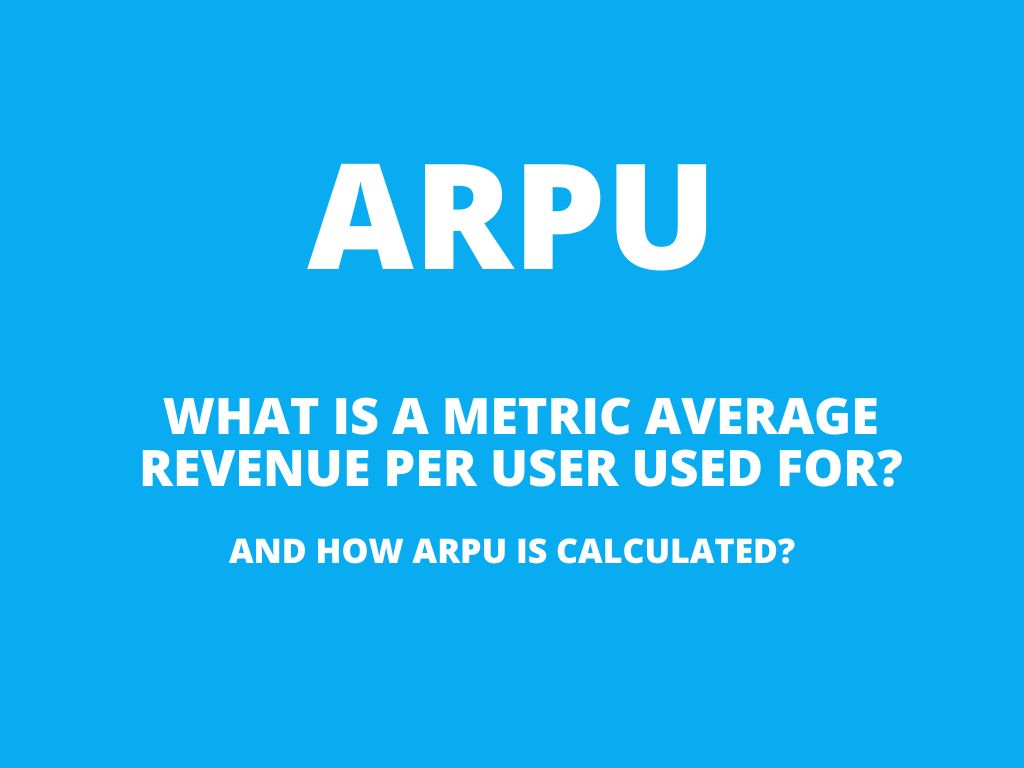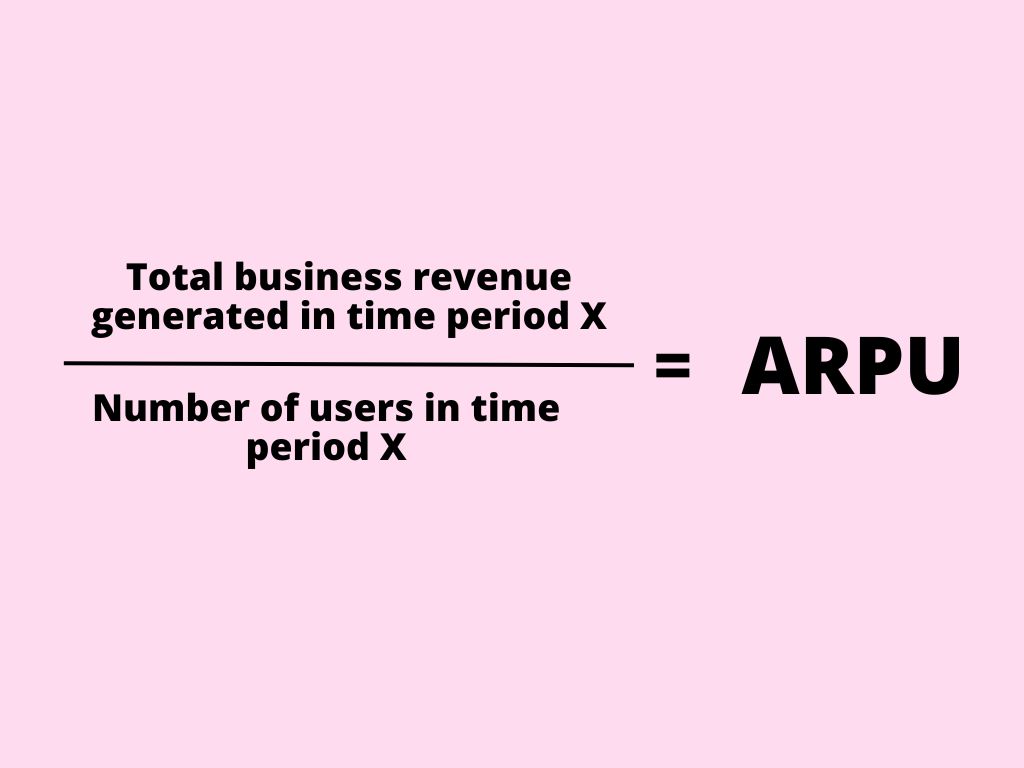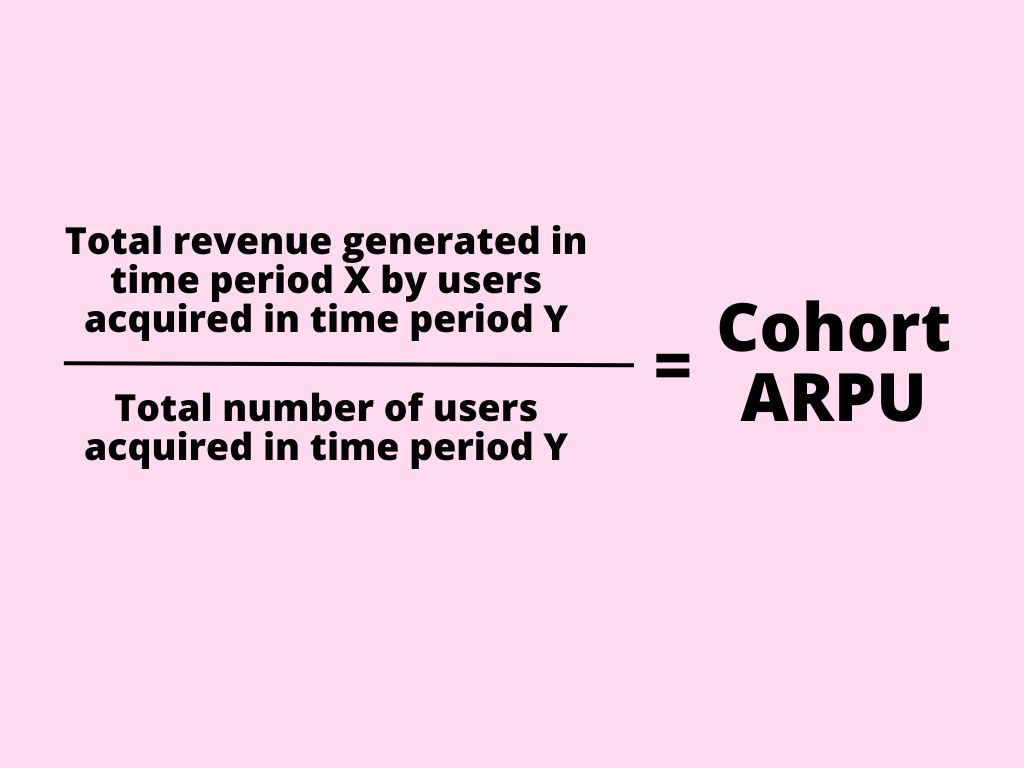
ARPU – what is a metric average revenue per user used for and how is it calculated?
The average revenue per user (ARPU) is a vital metric that helps businesses assess the amount of money they generate, on average, from each customer during a specific timeframe.
What is ARPU?
ARPU is calculated by dividing the total revenue of a business over a given period by the number of users within the same period. This metric provides insight into the average monetary value contributed by each user or customer.
Why is ARPU important? ARPU holds significant importance as it enables businesses to understand the average revenue generated from individual users within a specific time frame. This information empowers businesses to take action to enhance their success in the following ways:
- Optimize marketing activities: By determining higher-value and lower-value users based on ARPU, businesses can evaluate their marketing channels, networks, and campaigns to identify the most fruitful sources of revenue. This allows them to allocate resources effectively and eliminate underperforming strategies.
- Boost return on ad spend (ROAS): Comparing ARPU with acquisition costs such as cost per install (CPI) or cost per action (CPA) helps businesses evaluate their marketing performance and ROAS. This analysis helps in determining the efficiency of marketing expenditure and provides insights into areas that require improvement.
- Identify revenue opportunities: Analyzing the characteristics of high-value users allows businesses to explore strategies for increasing the number of customers in that segment. This can involve promoting higher subscription tiers, adjusting prices, or bundling services to offer enhanced value propositions that resonate with the target audience.
- Fine-tune business strategy: ARPU serves as an indicator of how well a business is meeting its customers’ needs. A declining ARPU may indicate customer dissatisfaction or potential churn, signaling the need to revamp product offerings. If acquisition efforts are successful but ARPU remains stagnant, it may be an indication of underpricing or ineffective communication of the value proposition.
- Assess business health: ARPU provides business leaders with a quick overview of performance, allowing them to gauge the overall revenue generation, compare against competitors, and make informed predictions about future performance.
By leveraging ARPU as a key metric, businesses can gain valuable insights into their revenue streams and make data-driven decisions to optimize marketing efforts, enhance customer value, and ensure long-term success.
Calculating ARPU – average revenue per user formula
Calculating ARPU is straightforward – you can use this simple formula:

Text formula – how is average revenue per user calculated: ARPU = total revenue/number of users
The time period you choose for calculating ARPU depends on your business model. Many mobile businesses and apps find it suitable to calculate ARPU on a monthly basis, especially for monthly subscription models like Netflix or Spotify, where monthly recurring revenue (MRR) is measured.
For example, let’s assume your subscription business generated $20,000 in revenue between June 1st and June 30th, and you had 10,000 users engaged with your brand during the same period. By dividing the revenue ($20,000) by the number of users (10,000), you would calculate an ARPU of $2.

For businesses that experience more sporadic usage patterns, such as those in the travel or eCommerce industries, opting for quarterly time periods may be more suitable. This is because their users tend to make purchases based on specific needs or desires rather than at regular intervals.
Regardless of the business type, it’s important to remember that when calculating ARPU, the total revenue should include contributions from new users, existing users, upsells, and cross-sells. This provides a comprehensive view of the revenue generated from various sources within the business.
Advanced calculation: Cohort ARPU
In addition to activity-based ARPU, mobile marketers often find it helpful to analyze cohort-based ARPU. A cohort refers to a group of users who share similar characteristics, such as the date of installation, geo-location, device type, and more.
Cohort-based ARPU focuses on the revenue generated by new users within a specific period of time. This analysis can provide valuable insights into the return on investment (ROI) of your mobile user acquisition (UA) efforts.
To calculate cohort-based ARPU, you can use the following formula:

Text-based formula – how is cohort average revenue per user calculated:
Cohort ARPU = Total revenue generated in time period X by users acquired in time period Y/Total number of users acquired in time period Y
To provide a more granular analysis, you can calculate the average revenue per user within a specific timeframe, such as 30 days (referred to as Day 30 ARPU), for all users acquired during a particular month. It’s important to note that even if a user installed your app or visited your website on the last day of the month, the revenue they generate over the subsequent 30 days would still be counted towards the cohort ARPU of that specific month.
What’s a good ARPU? How is the good result of ARPU determined?
Determining what constitutes a “good” ARPU depends on your business and industry. For example, a gaming app might rely on frequent, small in-app purchases, while an eCommerce app may generate less frequent but high-value orders. A streaming or well-being app with a monthly subscription fee will have a different ARPU profile altogether.
Ultimately, what matters is that the revenue generated by your customers covers your operational costs and ensures profitability. If your ARPU falls short, it’s essential to explore strategies to increase revenue per user and/or reduce expenses to achieve a sustainable business model.
What factors affect ARPU?
ARPU, or average revenue per user, can be influenced by several factors that are important to consider in order to make informed decisions and take appropriate actions:
- Pricing model: The pricing structure you choose for your products or services has a direct impact on ARPU. Regularly reviewing and adjusting your prices ensures that you provide value to your customers while maintaining profitability. Introducing premium subscription tiers with added benefits can help increase ARPU over time.
- Churn rate: High customer churn, where customers leave your business after a short period, can negatively impact ARPU, especially if these customers were high spenders. By focusing on customer engagement, continuously improving your offerings, and providing exceptional experiences, you can reduce churn and ultimately increase ARPU.
- User base: The spending habits of your user base play a significant role in determining ARPU. If the majority of your users have low spending levels, it can drag down the overall ARPU. To improve ARPU, it’s important to prioritize the satisfaction of your higher-spending customers and work on growing their numbers. Conversely, be cautious of relying too heavily on a small number of high-value users, as they can skew your ARPU figures. Analyzing user behavior and segmentation can help identify opportunities for improvement.
- Account set-up: In the case of professional services or B2B businesses, where a single paid account may include multiple users or seats, it’s essential to consider this when calculating ARPU. Including multiple users in a single account can lower the average revenue per user, so it’s important to factor this into your pricing strategy.
- Business strategy: ARPU can vary depending on the stage of your business and your specific goals. In the early stages, the focus may be on raising awareness and acquiring customers, which could involve offering discounts or free trials while your product or service is still evolving. As your business matures and establishes a solid customer base and reputation, you can shift your focus to revenue growth by offering additional features, upgrades, or higher-value packages.
By understanding these factors and their impact on ARPU, you can make informed decisions and implement strategies to optimize your average revenue per user, driving the overall financial success of your business.
ARPU for mobile devices
ARPU in the mobile ecosystem is crucial for app owners who heavily rely on in-app events to generate revenue. There are four primary ways to generate revenue from in-app events, each of which contributes to the overall ARPU calculation.
- In-app advertising (IAA): App owners can earn revenue by displaying relevant and well-designed ads within the app. In-app advertising is a growing market, and when executed properly, it can bring in significant revenue that increases with every view.
- In-app purchases (IAP): Encouraging users to make purchases within the app can significantly improve ARPU. However, it’s important to note that only a small proportion of users typically make in-app purchases. Analyzing user behavior and understanding who, where, when, and why users are making purchases can help increase the number of users making IAPs.
- Subscriptions: Offering regular app subscriptions can provide a steady income stream, particularly if users perceive the value they receive as worthwhile. Analyzing ARPU can help identify which pricing models resonate best with customers. Additionally, implementing a tiered subscription model allows for upselling opportunities, further growing ARPU.
- Paid apps: While a small percentage of apps in app stores are paid, users who download paid apps tend to be more loyal. However, meeting their expectations can be challenging. These users may expect an ad-free experience or resist paying for additional content. While ARPU may remain stable with paid apps, it can be difficult to significantly increase it.
By considering these four revenue streams and analyzing ARPU in each category, app owners can find the right balance to optimize their overall revenue and drive the financial success of their mobile app.
ARPU vs other metrics: what’s the difference?
ARPU vs ARPPU
ARPU (average revenue per user) and ARPPU (average revenue per paying user) may sound similar, but they have distinct differences. ARPPU focuses specifically on the average revenue generated by paying customers within a given time period. This metric is commonly used by app marketers operating under a freemium model, where revenue is generated through in-app purchases or advertising. ARPPU helps identify the high-value users, often referred to as “whales,” and determine which strategies are most effective in generating revenue. It is particularly useful when offering free trials, as non-paying users can be excluded from the calculation.
ARPU vs LTV
While ARPU looks at the average revenue per user over a specific time period, LTV (lifetime value) considers the entire duration of a user’s engagement with a brand, from the initial interaction to churn. Although the timeframes can be the same, LTV provides a more comprehensive analysis of a user’s value, including their behavior before churn and customer retention. LTV is crucial for optimizing return on ad spend (ROAS) and achieving a state where revenue per user exceeds the cost per user, indicating profitability.
ARPU vs ARPA
ARPA (average revenue per account) is a metric commonly used in Software-as-a-Service (SaaS) businesses. It is similar to ARPU but takes into account the fact that one account can have multiple users. It is valuable to analyze both new and existing ARPA to assess how accounts perform over time and address any issues. Further segmentation, such as by industry, client size, or onboarding date, can provide deeper insights into client preferences, engagement strategies, and opportunities for revenue growth.
ARPU vs ARPDAU
While ARPU provides an overview of revenue over any given time period, ARPDAU (average revenue per daily active user) focuses on the active revenue generated per user on a daily basis. ARPDAU is a short-term metric that allows real-time monitoring of results. For example, during a time-limited campaign offering discounted paid subscriptions, ARPDAU can immediately show the impact on the bottom line. However, ARPU provides a broader perspective on performance across channels and platforms over time, making it a better indicator of long-term success.
Potential limitations of ARPU
While ARPU (average revenue per user) is a valuable metric, it’s important to be aware of its potential pitfalls. Here are a few limitations to consider:
- ARPU only represents revenue: ARPU alone doesn’t provide a comprehensive view of your business’s profitability. Even if your ARPU is high, it’s crucial to analyze the cost of acquiring those users. Assessing ARPU alongside customer acquisition costs will give you a more accurate picture of your overall success.
- ARPU is based on a specific timeframe: Unlike metrics like LTV (lifetime value), ARPU captures a snapshot of revenue within a limited timeframe. It doesn’t reveal how long customers stay with your business or how their value may change over the long term. Temporary fluctuations in customer numbers can also impact the average for that period.
- ARPU is an average metric: Since ARPU calculates an average, it may not capture the full range of user behavior. It’s possible that a few high-spending users significantly skew the average, while the majority of users have lower spending patterns. By focusing on your highest-revenue users and understanding their characteristics, you can enhance retention strategies and aim to replicate that success across different user segments.
6 strategies to improve your ARPU
Improving your ARPU (average revenue per user) is crucial for maximizing revenue and business growth. Here are six effective strategies to enhance your ARPU:
- Adjust pricing plans: Evaluate your pricing structure and consider offering different tiers or plans. This could involve adding exclusive features to higher-priced plans or offering discounts for longer subscription commitments. Experiment with different pricing strategies to find the optimal balance that encourages users to upgrade and increase their spending.
- Optimize user acquisition (UA) campaigns: Analyze the performance of your UA efforts and identify the channels, creatives, or campaigns that attract high-value users with a higher ARPU. Allocate more resources to the successful channels and optimize your advertising spend to target audiences that align with your desired ARPU goals.
- Focus on retention: Prioritize retaining your most valuable users to maximize their lifetime value and increase ARPU. Implement retention strategies such as personalized remarketing campaigns, loyalty programs, and incentives for ongoing engagement. Address churn trends and proactively engage with users at risk of leaving to encourage their continued loyalty.
- Boost engagement: Keep your brand top of mind and increase user engagement by leveraging various tactics. Utilize push notifications to communicate new features or time-sensitive offers. Leverage your owned media channels, such as social media and email, to share relevant content that captivates your audience. Incorporate gamification elements to reward and engage users, encouraging regular usage and interaction with your product or service.
- Understand your customers: Develop comprehensive user personas to gain a deep understanding of your target audience. Tailor your product or service to meet their specific needs and preferences. Craft targeted marketing messages that resonate with your ideal customers and deliver them through the most effective channels. By connecting with your customers on a deeper level, you can improve acquisition and retention efforts, ultimately increasing ARPU.
- Explore cross-selling and upselling opportunities: Encourage existing users to upgrade or purchase additional products or services through upselling and cross-selling techniques. Offer premium subscriptions with enhanced features or suggest complementary offerings that align with their interests and needs. By effectively cross-selling and upselling, you can expand your revenue per user and boost overall ARPU.
By implementing these strategies, you can optimize your ARPU and drive sustainable revenue growth for your business.
Key information about average revenue per user (ARPU) to remember
ARPU, or average revenue per user, is a vital metric in marketing that provides insights into your revenue generation. Here are some key points to remember:
- ARPU is calculated by dividing your total revenue by the number of users within a specific time period. It gives you an average value of how much revenue you generate from each user and helps identify successful channels. Cohort-based ARPU focuses on the average revenue from new users, offering valuable insights into your user acquisition efforts.
- ARPU serves as an indicator of your business’s health and informs your strategic decisions. By analyzing ARPU, you can optimize your marketing activities, identify potential revenue opportunities, and adjust your strategies accordingly.
- It’s important to differentiate between ARPU and other similar metrics. ARPPU, or average revenue per paying user, looks specifically at revenue generated from paying users during a given period. ARPA, or average revenue per account, is commonly used in account-based SaaS businesses. ARPDAU, or average revenue per daily active user, is a short-term metric often employed by mobile apps.
- While ARPU focuses on a specific timeframe, LTV (lifetime value) covers the entire customer journey from the initial interaction to churn. LTV provides more comprehensive insights into customer value and retention.
- For mobile businesses, revenue generation typically occurs through in-app advertising (IAA), in-app purchases (IAP), subscriptions, and paid apps. ARPU helps assess the effectiveness of each revenue stream and guides decision-making.
Was this article helpful?
Support us to keep up the good work and to provide you even better content. Your donations will be used to help students get access to quality content for free and pay our contributors’ salaries, who work hard to create this website content! Thank you for all your support!

Reaction to comment: Cancel reply